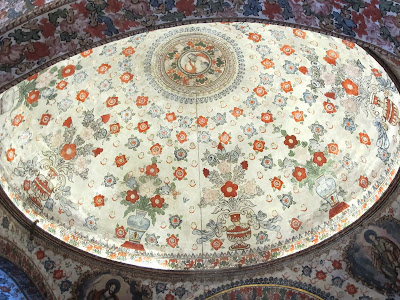The paved courtyard with its big shade trees is enclosed by white stucco walls with domes posas (a posa is a covered shrine or processional chapel at each corner in a monastery atrium).
It was a special day when my group and I visited the church. It was St. Jeronimo's saint's day!
The pink stucco facade is typical Baroque. In the niche above the main door, you will find St. Jeronimo kneeling in penitence before the crucifix, one hand holding a rock and the other resting on a skull while listening to the voice of God through a trumpet. As we saw the other day at the Cuilipam monastery, there are two dogs holding a burning torch in their mouths - a symbol of the Dominicans.
Specially made plastico picados were made for the occasion and strung throughout the courtyard.
A few families in
the town are chosen each year to decorate the courtyard and church in
honor of St. Jeronimo. I would bet that the competition gets harder every year when the one group of families attempts to outdo last years presentation.
The main altar was over the top with the flowers and the hand-made ceremonial beeswax candles. What a lavish display of devotion.
I found the Cristo de Cana crucifix with its twisted arms and emaciated body somewhat eerie with the almost cheery background of brightly painted flowers and urns. Cristo de Cana is a light weight processional crucifix made out of corn pith and orchid glue. This is a process that was introduced by Don Vasco in the state of Michoacan in the mid 1500's and many of the Churches in the states of Guanajuato, Michoacan and Oaxaca have Cristo de Canas dating back to that era.
Then you come upon the simple figure of Christ entering Jerusalem on his donkey that is a little bit out of proportion. I just love all the folk art and images one finds in these old, colonial churches.
Looking back to the entrance of the church, you will see the choir above.
The choir is the only space in the church that has a domed ceiling.
After a perilous climb up the dark, circular stairway with its steep and narrow steps, we were pleasantly rewarded by the magnificent, colorful old organ. There is a non-profit organization in Oaxaca City that was created in 2009 solely for the preservation of the old and rare organs that are located in over sixty churches in the area.
With all the gilding, decorative surfaces, paintings, retablos.... There is an immediate serenity to the humble convent behind the church.
Even with all the decorative richness in the main church, the view through the side door that was open just for a few minutes was breathtaking. The San Jeronimo Church is such a gem in so many ways and we were so fortunate to be there on the day the townsfolk were celebrating St. Jeronimo.
















No comments:
Post a Comment